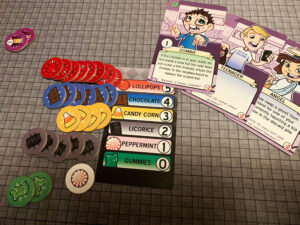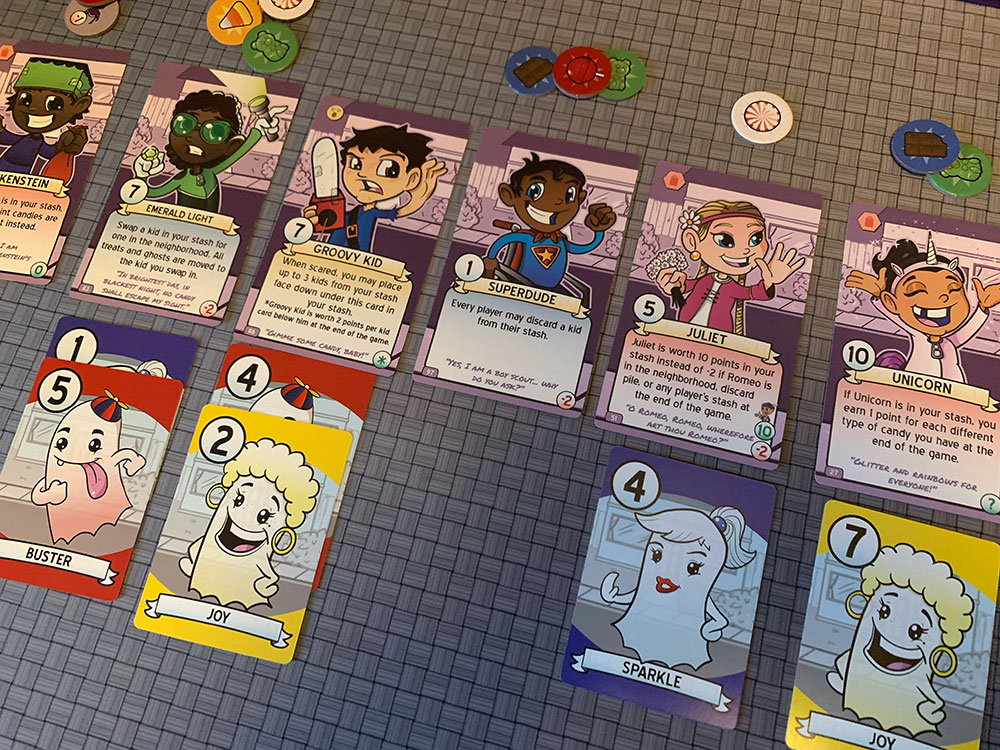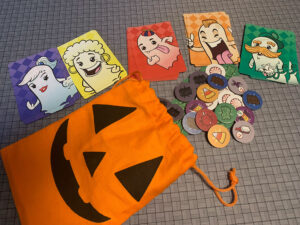 Halloween is one of my favorite holidays. Partly because it makes me think of fall and part of it is nostalgic. I loved Halloween as a kid (who doesn’t love dressing up and getting candy) and as a younger adult (who doesn’t love dressing up and having drinks next to an awkwardly revealing ghost costume and someone dressed up as a lamp post). Now as a parent, I can watch my son be enthralled by the kickoff of the pumpkin-spice season, just as I was.
Halloween is one of my favorite holidays. Partly because it makes me think of fall and part of it is nostalgic. I loved Halloween as a kid (who doesn’t love dressing up and getting candy) and as a younger adult (who doesn’t love dressing up and having drinks next to an awkwardly revealing ghost costume and someone dressed up as a lamp post). Now as a parent, I can watch my son be enthralled by the kickoff of the pumpkin-spice season, just as I was.
Ghosts Love Candy Too is a competitive game about Ghosts haunting kids to take their candy but hopefully not enough to scare them away. It plays two to six players and lasts about 30 to 45 minutes.
Gameplay Overview:
Each player will start the game with a hand of cards individually numbered from one to nine and a ghost of their choice. In the middle of the table is a number of costumed kid cards that represent the kids trick or treating around the neighborhood (this varies between six and eight kids depending on the player count).
Each player is also given a craving card that gives them a key for what candy will be worth to them from five points per piece to zero. There are also some full-size bars that are worth five points to everyone because who doesn’t like full-sized candy bars?

Each round plays out as follows in three phases:
• Phase 1: Place treats – Add one treat to each neighborhood kid. If a junk treat is drawn, add another treat until they get a candy.
• Phase 2: Determine Turn Order – Each player selects the card they want to play. Higher numbers go faster but are more likely to scare the kids away (more on that later). Players all reveal their cards and the turn order is established from highest to lowest.
• Phase 3: Take your Turn – In turn order, choose a kid to haunt. Unless otherwise specified, grab all the treats on their card. Then resolve the kid’s ability, if they have one. If the sum of the card or cards haunting the kid exceeds their courage value, they are scared off and a new kid joins the neighborhood. When you scare a kid they go into your stash where your candy is.
The fine print on scaring kids is most of them are worth negative points. But some others might have special powers like turning one or more types of junk treats (like spider rings, toothbrushes, etc.) into a positive value.
The game ends when all players have played all of their cards or after round six at higher player counts. Then scores are tallied and the person with the most points wins. Ties are broken by who has the most of their favorite types of candy.

Game Experience:
Despite the cute appearances this game has more strategy than you’d expect. It’s something gamers can enjoy while still being fairly accessible and quick playing. Discarding your worthless candy seems like an easy decision but if you notice one of your opponents gobbling those up like Pac-Man maybe that’s not the best call. Some kids’ powers take candy from other players so there is also a little “take that” sprinkled in there.

But what takes the edge off of that factor is that you generally have a lot of candy so losing one piece doesn’t feel horrible and you often get to choose what you give up. And in many cases treats the neighborhood kids are taking from you end up being available to take back if you haunt the kid in a future turn. Maybe it is worth scaring a kid off for the negative points to gather up all that sweet loot and two rocks.
Having played the game with two players (both each controlling one ghost and as suggested with the controller two ghosts each which would play much like four players in terms of interactions) and three players the game works well at different player counts. More players means more variability in what’s desirable (or not) and increases the churn of the neighborhood kids. And with a group that leans into the spirit of the game and enjoys the pop culture references and theme, it’s a lot of fun.
With a large deck of neighborhood kids, each game has been different as the interactions vary both between the neighborhood kids and the players. But at the same time, the game is centered around a single mechanic of playing a card and collecting candy with the card value determining if the kid is scared or not and how fast you go. This simplicity makes it gateway accessible but I don’t expect this to replace your favorite medium weight game.

The art and attention to detail for the kids’ costumes and powers are amazing and is super fun to see as they are revealed. I love the interaction between cards like the lovestruck girl is worth 10 points unless the vampire or werewolf are in someone’s stash or the discard pile which forces some risk/reward decisions as you weigh when to scare off some kids. There’s a lot of pop culture references like that Twilight reference sprinkled throughout the game that should amuse a lot of players. It was also cool to see diversity in the depiction of the children as well as a few that were using wheelchairs.
If I had to nit-pick something it would be a few of the cards can be a little confusing at first glance but a lot of that is keeping terminology straight and referencing some of the icons that explain if the effect is ongoing, end of game, etc.
25th Century Games paid a lot of attention to the little details and that includes drawing the treats out of a pumpkin-themed bag reminiscent of the plastic pumpkins a lot of kids carry around while Trick-or-Treating. If there was a thematic disconnect it’s the stashing of scared kids (mechanically I get that scaring them is generally bad) and incorporeal beings collecting Halloween candy but that’s kind of the hook so if a ghost can rock a hat and monocle, they can steal candy.
Final Thoughts:
I was expecting a light family game and found an easy-to-teach game that could play well with families, gamers, or newcomers to gaming. The cute art and pop culture references in Ghosts Love Candy Too elevate it for me as I want to see the various costumes in the 100-card deck. The strong theming of the game is awesome for Fall but may not be top of mind for a summer gathering of friends.
Final Score: 3.5 Stars – A cute game built around a simple concept that should appeal to a lot of Halloween fans.
 Hits:
Hits:
• Easy to teach and accessible gameplay
• Cute art with thematic abilities
• Huge deck of costumed kids provides a lot of replay value
Misses:
• A few cards can be confusing at first
• Light weight gameplay may lack staying power year-round
Source: Board Game Quest





